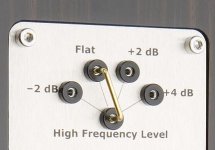Those kind of things look totally manufactuer specific. I've never come across anything like that in all the years of looking at parts catalogues etc. Easy to make one though 🙂
Those kind of things look totally manufactuer specific. I've never come across anything like that in all the years of looking at parts catalogues etc. Easy to make one though 🙂
Thank you for reply.
I was thinking also to build it myself but I need quality connectors. Do you have something in mind?
Only to use decent terminations of some sort. These kind of things are really set once and forgotton rather than constantly altered.
If I was doing it myself I might even favour a small "open" PCB with the print side showing and use solder bridges for the connections. Could be made very small and guaranteed perfect connectivity with no degradation.
If I was doing it myself I might even favour a small "open" PCB with the print side showing and use solder bridges for the connections. Could be made very small and guaranteed perfect connectivity with no degradation.
Just another set of speaker terminals, which you will use in your speakers.Do you have something in mind?
And use jumpers to short them.
How about using a dual banana male plug, wired as a shunt. Then make a pattern of five banana female single jacks, similar to the pattern of your example. Plug the banana shunt from the common to whichever option you desire. COme to think of it, they make special dual banana plugs that are already wired shunt internally.
For many years, in guitar amps, Marshall used an impedance selector socket with a moveable jumper plug that worked exactly as your example does, though it looked different. They later replaced it with a rotary switch.
Unless the cosmetics are important to you, certainly a rotary switch ought to work.
For many years, in guitar amps, Marshall used an impedance selector socket with a moveable jumper plug that worked exactly as your example does, though it looked different. They later replaced it with a rotary switch.
Unless the cosmetics are important to you, certainly a rotary switch ought to work.
- Status
- Not open for further replies.
- Home
- Design & Build
- Parts
- Attenuator terminal for speakers
